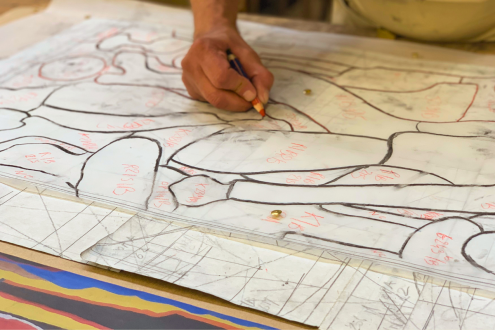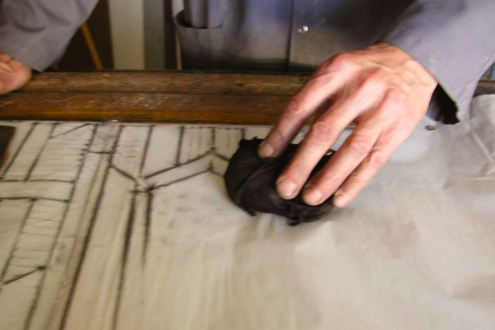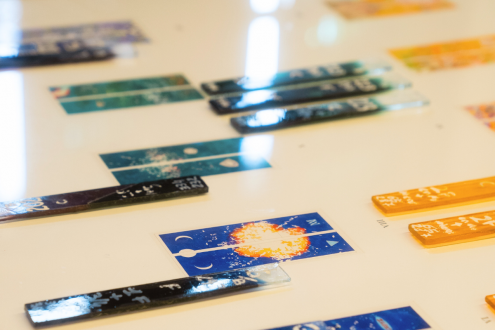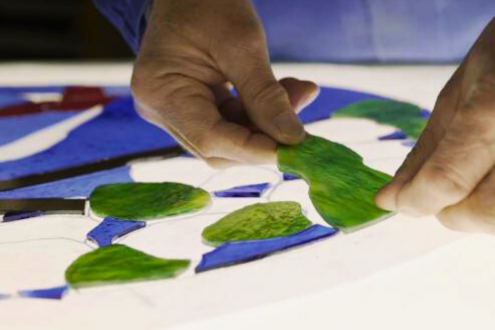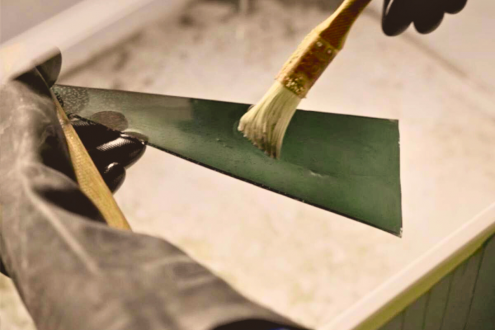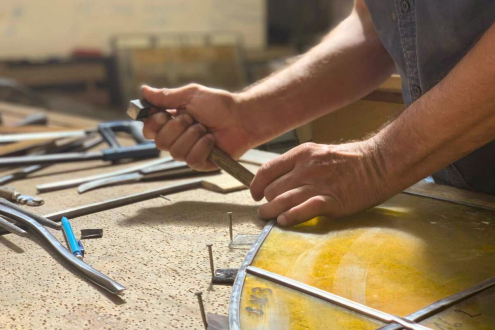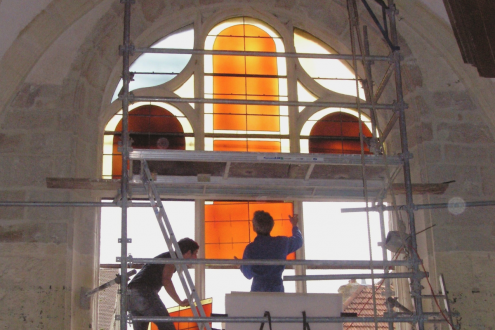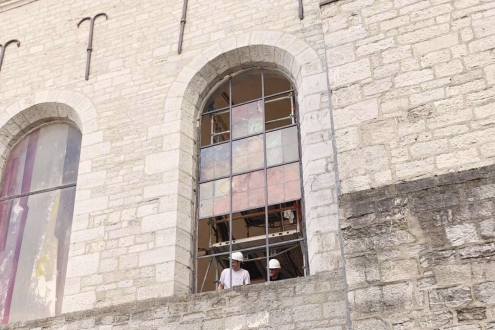Mastering the art of stained glass
For 12 generations, the Atelier Simon-Marq has put its expertise and ancestral craftsmanship at the service of creating and restoring stained glass. Descended from a long line of illustrious master glassmakers, the Workshop benefits from a precious heritage, continually evolving with the innovations and developments in glasswork.
Contemporary artworks
Simon-Marq’s heart beats for art. The studio created the stained glass windows designed by renowned twentieth-century artists such as Marc Chagall and Maria-Héléna Vieira da Silva, helping this religious art form to thrive in France and around the world.
Contemporary artworks
Simon-Marq’s heart beats for art. The studio created the stained glass windows designed by renowned twentieth-century artists such as Marc Chagall and Maria-Héléna Vieira da Silva, helping this religious art form to thrive in France and around the world.
Heritage conservation
For several generations, the artisans of the Atelier Simon-Marq Studio have practiced all type of conservation operations that contribute to the protection, preservation, and enhancement of ancient stained glass. The Workshop strictly adheres to traditional practices while closely monitoring the evolution of techniques.
Heritage conservation
For several generations, the artisans of the Atelier Simon-Marq Studio have practiced all type of conservation operations that contribute to the protection, preservation, and enhancement of ancient stained glass. The Workshop strictly adheres to traditional practices while closely monitoring the evolution of techniques.
lead cames
Creation with the artist
The “cames” are the lead rods that are arranged in a particular pattern and which hold the stained glass in place. Creating a pattern of cames for a stained glass artwork requires artistic sensitivity and technical skill in order to remain faithful to the artist’s intentions while taking mechanical constraints into account. The lattice of cames is like an artwork in its own right, based on enlargements of the original drawing on the scale of the stained-glass window itself.
Creation with the artist
The “cames” are the lead rods that are arranged in a particular pattern and which hold the stained glass in place. Creating a pattern of cames for a stained glass artwork requires artistic sensitivity and technical skill in order to remain faithful to the artist’s intentions while taking mechanical constraints into account. The lattice of cames is like an artwork in its own right, based on enlargements of the original drawing on the scale of the stained-glass window itself.
Rubbing
Rubbing is a technique that provides a full-size representation of the lead cames. A rubbing is usually made by placing a piece of thin paper over the stained-glass panel and rubbing it with a block of waxy or dry material so that the pattern of cames appears on the paper. Much care must be taken so as not to damage the stained glass. This work is necessary to keep a permanent record of a stained-glass panel or as part of a restoration project.
Rubbing
Rubbing is a technique that provides a full-size representation of the lead cames. A rubbing is usually made by placing a piece of thin paper over the stained-glass panel and rubbing it with a block of waxy or dry material so that the pattern of cames appears on the paper. Much care must be taken so as not to damage the stained glass. This work is necessary to keep a permanent record of a stained-glass panel or as part of a restoration project.
Selecting the glass
Choosing colours
We mostly work with mouth-blown glass, traditionally handcrafted at the Saint-Just glassworks near Saint-Etienne, France. The shimmering colors of each glass sheet vibrate uniquely and intensely. Our extensive color palette includes over 1,100 shades. Selecting just the right tones is essential for the success of each project.
Choosing colours
We mostly work with mouth-blown glass, traditionally handcrafted at the Saint-Just glassworks near Saint-Etienne, France. The shimmering colors of each glass sheet vibrate uniquely and intensely. Our extensive color palette includes over 1,100 shades. Selecting just the right tones is essential for the success of each project.
Treating the glass
Assembly
Mounting and puttying
Since the Middle Ages, stained glass has traditionally been set in lead cames, held together by soldering at each intersection. Putty – a mixture of linseed oil, soot, chalk, and a drying agent, according to the Studio’s unique recipe – is then applied to each panel, ensuring their waterproofing and rigidity. The Workshop continues to use this time-tested technique of leading and glazing, ensuring a lifespan of approximately 100 years for the treated stained glass windows.
Mounting and puttying
Since the Middle Ages, stained glass has traditionally been set in lead cames, held together by soldering at each intersection. Putty – a mixture of linseed oil, soot, chalk, and a drying agent, according to the Studio’s unique recipe – is then applied to each panel, ensuring their waterproofing and rigidity. The Workshop continues to use this time-tested technique of leading and glazing, ensuring a lifespan of approximately 100 years for the treated stained glass windows.
Modern techniques
The fusing technique offers a new means of expression, more flexible and pictorial, by fusing layered glass pieces during firing. Glass collage allows for the juxtaposition and assembly of pieces on mechanical glass, also paving the way for the creation of pieces with non-standard dimensions. Finally, brass also allows for glass assembly, serving as a more durable substitute for lead. Opening the door to new graphic compositions, these creative solutions exist today to avoid the use of lead.
Modern techniques
The fusing technique offers a new means of expression, more flexible and pictorial, by fusing layered glass pieces during firing. Glass collage allows for the juxtaposition and assembly of pieces on mechanical glass, also paving the way for the creation of pieces with non-standard dimensions. Finally, brass also allows for glass assembly, serving as a more durable substitute for lead. Opening the door to new graphic compositions, these creative solutions exist today to avoid the use of lead.
On-site operations
Installing stained glass
The Atelier Simon-Marq also ensures the installation of its stained glass in all types of buildings or homes. We combine our expertise with that of other trades, including for the creation of metal or wooden frames. Depending on the installation, protective glazing can be added with a simplified lead pathway.
Installing stained glass
The Atelier Simon-Marq also ensures the installation of its stained glass in all types of buildings or homes. We combine our expertise with that of other trades, including for the creation of metal or wooden frames. Depending on the installation, protective glazing can be added with a simplified lead pathway.
